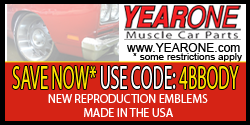The first start of problems are aftermarket parts. Does it really fit? They will need careful examination. The second are you changing factory parameters? Lets say a larger cam. What changes? The valve is open longer, further, and faster. What does this impact? Weight of valve train vs spring pressure. Does the retainer clear the seal and guide boss? Does the valve clear the piston. Are the springs strong enough to control the motion? Are the valves, keepers, locks up to the task of the added spring pressure? Do the stronger springs fit the retainer, head, and guide properly? Are the pushrods strong enough? Which rockers fit? Is the valvetrain geometry close enough? Or does it need to be modified? This is just one of many examples. These engines are close to 50 years old. Stuff wears out that was never envisioned years earlier. Threads in the castings, lifter bores wear, water jacket corosion, core shift, cracks. Why is my current race motor better? It has really good parts and machining. The combo of parts work very well together. .9mm thin rings with round straight high end hone job, precision valve job, high end porting and chamber work, bushed lifter bores, better internal oil control. It doesn't have the most expensive parts. But it does have pretty high end internals. I could have never afforded this stuff when I was younger. Currently 580" Mopar mega block, Indy -1 w/.225" Ferrea valves, T&D paired shaft rockers, Trend 7/16"x.165" pushrods,15.1-1, 285/296@.050", .830"/.800", Molnar crank and rods, Jessel belt drive, custom aluminum pan w/swing, swing trap doors & pick up , external oil feed Indy pump, GZ vacuum pump, crank scraper, Indy 440-25 cross ram, 2 1100 Lightening racing custom built Holleys. This engine bought today would probably cost $25-30K. This is a far cry from my first 440 that didnt get honed. Just new rings and a .030"/.030" crank and bearings, and a nice valve job, and a Gratiot Auto Supply cam that wasn't degreeded and used the factory valve springs. It also featured stock A body 383 manifolds and pipes. And an iron 6 pac manifold with 3 unknown Holleys with accelerator pumps instead of vacuum linkage.
Doug
I'm taking a running engine apart, looking for obvious defects and checking a few things, then putting it back together again with the new heads. So, at least I know everything works together. In all honesty, if I had to worry about all the stuff above, I probably wouldn't bother and just ship it off to someone LOL
Mostly I want to know exactly what's going on with the engine so that I can better diagnose issues down the road. I.E. with my current issue: People keep asking if I'm sure the cam was degreed in properly and/or the timing chain etc was installed correctly. No. No I'm not. I have no idea. LOL but also

















